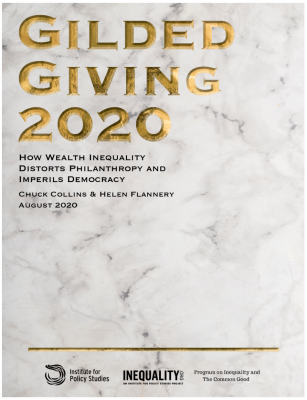Gilded Giving 2020:
How Wealth Inequality Distorts Philanthropy and Imperils Democracy
Chuck Collins | Helen Flannery
Introduction:
Ten years ago, in August 2010, several dozen U.S. billionaires led by Bill Gates and Warren Buffett pledged to give away at least half of their wealth before their death. Many have donated considerable sums to charities and foundations since then. But as a group, these billionaires have seen their fortunes skyrocket in the decade since the so-called Giving Pledge was launched.
The wealth of the billionaire class is growing so fast, it’s simply outstripped their capacity to give it away. But in a time of acute charitable need, there’s another growing concern in the broader charitable sector: Most of these funds may end up in family foundations and donor-advised funds that could legally exist in perpetuity — without ever supporting real, on-the-ground charitable work.
Over the last two decades, charitable giving has been on a steady upward trajectory. But this growth has masked a troubling trend: Charity is becoming increasingly undemocratic, with organizations relying more on larger donations from a smaller number of wealthy donors, while receiving shrinking amounts of revenue from donors at lower-and middle-income levels.
What’s more, a growing share of these high-end donations go not to the organizations that actually perform charitable work, but to tax-privileged private foundations and donor-advised funds that pay only a small percentage of their assets to support working charities. These vehicles offer substantial tax benefits to donors, but may then hoard most or all of these donations in their endowments, drastically limiting what’s available to on-the-ground nonprofits.
This poses a growing risk to the independence of the nonprofit sector, the integrity of the tax system, and the health of our democracy — and that was before two new existential threats to the nonprofit sector: the GOP tax cut package that passed in 2017, and the COVID-19 pandemic and recession, both of which are likely to concentrate more wealth at the top while hurting the ability of people of ordinary means to give.
Diminished giving threatens to exacerbate philanthropic inequity even further at a time when the demand on charities is increasing. This is not the time to discourage broad philanthropic participation, or to hoard charitable revenue in wealth-preservation vehicles. Gilded Giving 2020 examines several possible implications of these conditions and suggests some solutions.
Key Findings

The wealth of Giving Pledge signers is skyrocketing.
- Of the 62 people who signed the Giving Pledge that were billionaires in 2010, their combined wealth has almost doubled — from $376 billion in 2010 to $734 billion as of July 18, 2020, in 2020 dollars.
- Nine of those 62 billionaires have seen their wealth increase over 200 percent over the decade. These include Mark Zuckerberg (1,783 percent), John Doerr (416 percent), Marc Benioff (400 percent), Ken Langone (288 percent), and Stephen Schwarzman (245 percent), among others.
- Over the four worst months of the COVID-19 pandemic, the 100 living Pledgers who were billionaires in March 2020 saw their combined wealth increase by $213.6 billion — or 28 percent — from $758.3 billion on March 18 to $971.9 billion on July 17, 2020.
Philanthropy is increasingly a province of the wealthy.
- Amid rising economic precariousness for the working and middle classes, small donor giving has been steadily declining for two decades. Between 2000 and 2016 (the most recent data), the percentage of households giving to charity has dropped from 66 percent to 53 percent. Any increase in giving has been driven by donations by mega-donors and mega gifts over $300 million.
- The percent of total charitable deductions claimed by households making over $1 million grew from 12 percent in 1995 to 33 percent in 2017.
Philanthropy is increasingly unaccountable — and taxpayers are subsidizing it.
- Between 2005 and 2019, the number of tax-advantaged private foundations grew from 71,097 to 119,791, an increase of 68 percent. Over the same period, their assets more than doubled, from $551 billion to $1.2 trillion. The proportion of all charitable dollars going into private foundations has tripled over the past 30 years.
- Donations to DAFs, which are not required to spend down their assets, have increased even more rapidly. DAFs have seen their share of the giving pie triple between 2010 and 2018. And over the past three years, six of the top 10 charity recipients have been DAFs.
- When donors take tax write-offs for these gifts, that leaves ordinary taxpayers to cover the tab. If the 100 living U.S. Giving Pledgers gave away half of their wealth — an estimated $485.8 billion — today, the loss of tax revenue to the U.S. Treasury would be as high as $360 billion.
We need a Charity Reform Agenda to protect charities from the undue influence of wealthy donors, prevent abuse of our tax system, incentivize broad-based giving by all segments of society, and make sure charitable dollars quickly get to the public interest organizations that need them the most.
Currently, the private foundations consuming an increasing share of all giving are required to spend just 5 percent of their assets on charitable contributions each year. Donor-Advised Funds, or DAFs, have no minimum payout at all.
To meet the needs of the immediate crises posed by COVID-19 and the recession,
- Congress should implement an Emergency Charity Stimulus — a three-year emergency mandate to require private foundations to double their payout from 5 percent to 10 percent and establish a temporary 10 percent payout requirement for DAFs. This would move an estimated $200 billion off the sidelines and into front-line working charities without increasing taxes or adding to the deficit.
In the longer term, the rules governing philanthropy should be overhauled to maximize the public good. Proposed reforms include:
- Levy a wealth tax on closely held private foundation assets and establish a lifetime cap on charitable deductions.
- Make private foundation payout requirements meaningful and increase the flow of funds to working charities. Eliminate the perpetual private foundation as it is currently constituted.
- Require donor-advised funds to have a payout and increase transparency and reporting.
- Implement a universal giving credit to broaden giving by the non-wealthy.
- Prevent abuses and encourage transparency with reforms requiring board independence, banning compensation of family members, and donor disclosures.
- Create a new federal oversight agency for foundations and charities, funded by foundation excise taxes.
